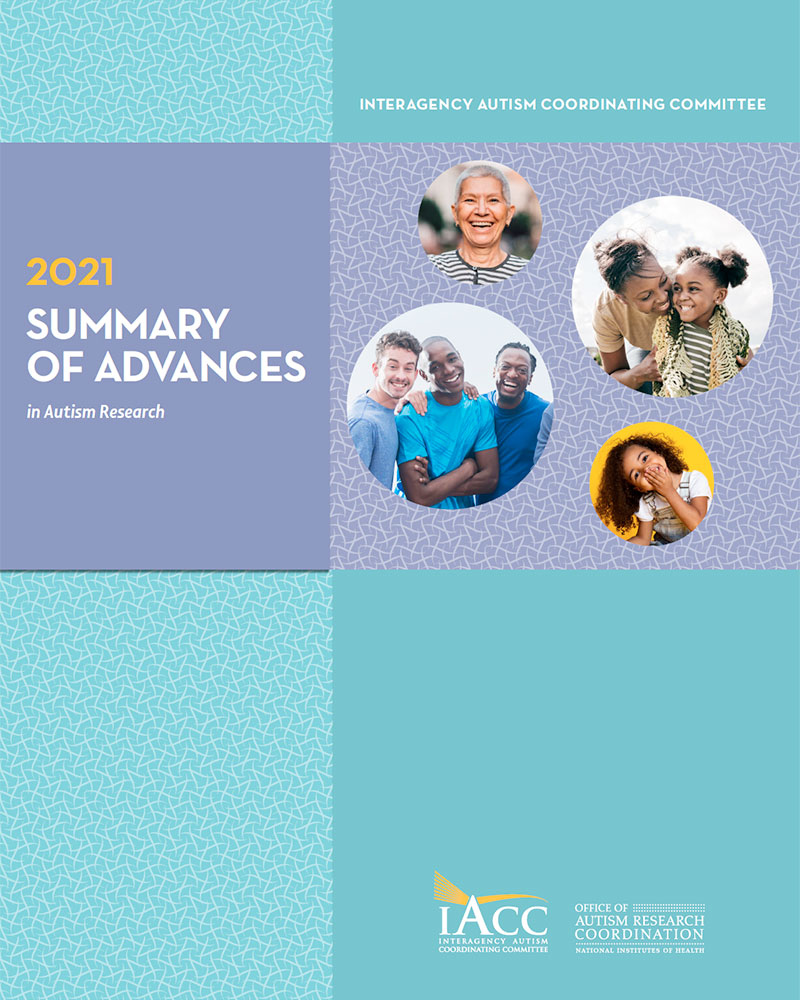Summary of Advances
In Autism Research
2021
Overview
The Summary of Advances in Autism Research provides short, plain language summaries of the top 20 advances in autism biomedical and services research selected by members of the Interagency Autism Coordinating Committee (IACC). Articles in the Summary of Advances are grouped according to the topics represented by the seven Questions of the 2016-2017 IACC Strategic Plan for ASD (screening & diagnosis, biology, genetic & environmental factors, interventions, services & supports, lifespan, infrastructure & prevalence). In addition, the IACC has released an accompanying easy-read version that summarizes the full publication in a briefer, more accessible format.
Each year, the IACC releases a list of scientific advances that represent significant progress in the field of autism research. The 2021 Summary of Advances provides short, plain language summaries of the top research breakthroughs selected by the IACC from a pool of research articles nominated by the members. Read more.
Articles Selected for the 2021 Summary of Advances
1) Race/ethnic inequities in conjoint monitoring and screening for U.S. children 3 and under: Disparities in Monitoring and Screening. 2) Effect of Family Navigation on Diagnostic Ascertainment Among Children at Risk for Autism: A Randomized Clinical Trial From DBPNet. 3) Sex differences in scores on standardized measures of autism symptoms: a multisite integrative data analysis. All articles.
Race/ethnic inequities in conjoint monitoring and screening for US children 3 and under. Hispanic and Black children are less likely to receive combined screening and monitoring for developmental disabilities. Read more.
Early social communication development in infants with autism spectrum disorder. Infants that are later diagnosed with autism exhibit differences in social communication skills at 9 to 12 months of age. Read more.
Genetic and Environmental Factors
Impact of autism genetic risk on brain connectivity: a mechanism for the female protective effect. Genes associated with autism impact activity in certain parts of the brain more in boys than in girls. Read more.
Medication Use in Youth With Autism and Attention-Deficit/Hyperactivity Disorder. Children with both autism and ADHD take more medication than those with only autism or only ADHD and may have distinct care needs. Read more.
Analysis of the SPARK study COVID-19 parent survey: Early impact of the pandemic on access to services, child/parent mental health, and benefits of online services. Early COVID-19 service disruptions affected children on the autism spectrum and their families to varying degrees, showing the need for in-person, virtual, or hybrid healthcare and family support services based on family preferences and needs. Read more.
Self-reported parkinsonism features in older autistic adults: A descriptive study. Many older autistic adults without intellectual disabilities report having more symptoms associated with Parkinson's disease, such as stiffness and slow movements. Read more.
Prevalence and Characteristics of Autism Spectrum Disorder Among Children Aged 8 Years - Autism and Developmental Disabilities Monitoring Network, 11 Sites, United States, 2018. CDC data from 2018 estimated that 1 in 44 eight-year-old children in the U.S. have a diagnosis of autism. Read more.




